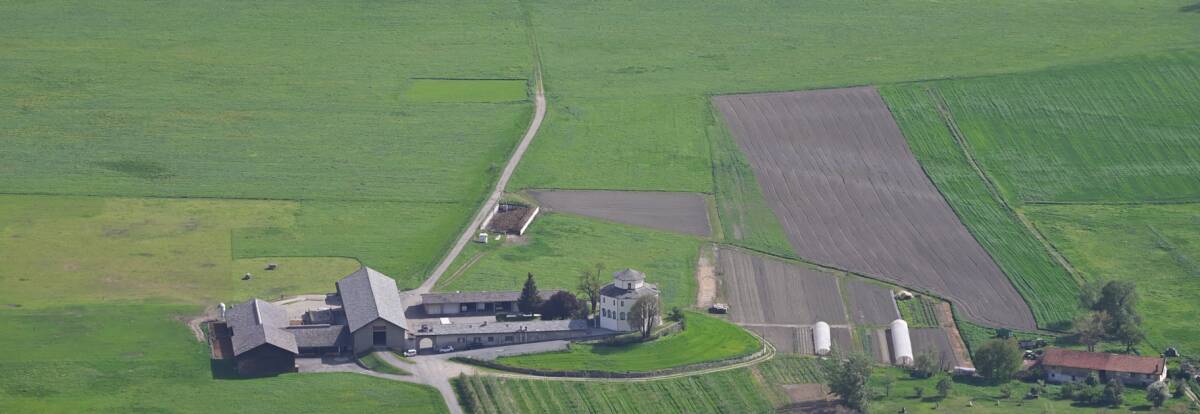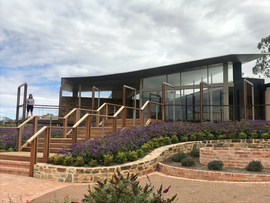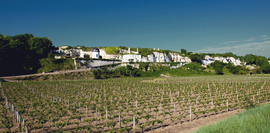Tiny, alpine, and semi-autonomous, the Valle d’Aosta is Italy's smallest and least populous region. A speck squeezed into the country’s northwestern corner, it is dwarfed on all sides by its more imposing neighbors. Piedmont, 8 times as large, surrounds the valley to the east and south, while its western and northern boundaries are shaded by a pair of Europe's most majestic peaks: Mont Blanc, which marks the border with France, and the Matterhorn, where you can stare into Switzerland.
It is, as you might imagine, a stunningly beautiful place, composed of stream and waterfall stippled mountain frescoes, and hosts world-class ski resorts, medieval castles, and the well-preserved ruins of its various historical inhabitants. Though the Celts came first, the most important of these for our purposes are the Romans and the French. The former founded the capital city of Aosta after conquering the territory from the Celtic Salassi tribe in 25 BCE and, though there is limited evidence of winemaking that predates their arrival, it was likely the Romans that established meaningful viticulture in the area. After the fall of the Roman Empire, the Valle D’Aosta came under the control of the Frankish Burgundy, and while never officially part of France, it retains a significant Gallic accent to this day, starting with the fact that it is officially bilingual. (In fact, it adopted French as its official language in 1536 - three years before France itself!)
Though the Francophone influence runs through the region's culinary and viticultural traditions as well, the Valle D’Aosta ultimately seems like a world unto itself - or several in fact. For while it finishes dead last in most Italo-vino metrics - acreage under vine, volume produced per annum, # of DOCs (there is one to cover the whole region) - you could argue it leads the field in the kind of categories most likely to yield interesting wine. Take topography: starting from 345 meters above sea level at the border with Piedmont in the southeast, the Valley climbs steadily upward towards the west, cresting, wine-wise, with some of Europe's highest commercial vineyards. The historic and steep Rovettaz vineyard, which perches some 700 metres above sea level, is the source of our white wine this month, made from 100% Petit Arvine, by the Grosjean clan, a multi-generational concern that pioneered organic viticulture in the region.
It's only a slightly different story lower in the valley, where the bulk of the wine, most of it red, is produced. Prior to phylloxera, the valley had around 3000 hectares under vine, supporting a surfeit of different varietals. Unfortunately the notorious pestilence that swept through Europe in the 1860s felled most of these, wiping out much of the area’s wine heritage. Starting after World War II however, strenuous efforts have been made to recover and extend that tradition. Today there are some 24 varietals growing in the Valle D’Aosta, 13 of them indigenous, planted on only 436 hectares. The region’s unique oenological endowment has been recognized in the form of the Institut Agricole Regional (IAR), an agricultural school, research center, and working farm that studies, preserves, and vinifies native varietals. Our red this month is a casually complex blend wrought from the local grapes Mayolet and Vuillermin (first I’ve heard of either) and some Nebbiolo and Cabernet Franc, presumably to make us tourists feel more comfortable.
The farming conditions remain quite inhospitable however - grapes are grown on terraces, stair step-style levels cut or built into the sides of the slopes, with pergolas (overhead trellises) to support the vines, all of which must be harvested by hand - and the yields miniscule (there is no demand for bulk wine from the region). Winemaking in the Valle D’Aosta requires an extreme enough level of passion and dedication that it is known ‘heroic viticulture’, a condition official enough to come with environmental prerequisites (altitude of at least 500 metres, inclination over 30%.) The reward, certainly for the drinkers (and hopefully for the vignerons) is some of the most vivid juice you’re likely to encounter, each bottling a synecdoche for the cloudland from which it descends.
Salut,
Alan Hicks - Wine Buyer, Noe Valley
|
Grosjean Petite Arvine Rovettaz 2023 |
|
|
Region: Valle de Aoste AOC |
About the Winery: The Grosjean family traces its roots back to the village of Fornet in the high mountain passes of the Valle d’Aosta known as Valgrisenche where they raised cattle. During the summer months, the family cultivated grapes and chestnuts on the slopes at lower altitude, stocking up on wine to supply themselves over the long winters. In 1969, Dauphin Grosjean, the father of the five sons that now collaborate to produce the wines of this estate, was encouraged to present his wine at the local “wine expo”. The exceptional quality of his work was recognized and the entire family became engaged in the expansion of the vineyards and in the production of wine. The estate has now grown to encompass seven hectares of vineyards. The domaine is located in the hamlet of Ollignan on the border of the towns of Quart and Saint Christophe and includes “cru” vineyard sites such as Tzeriat, Rovettaz, Creton and Touren in Quart, plus Tzantè de Bagnere, Merletta and Castello di Pleod in Saint Christophe. After starting out with the traditional Petit Rouge along with some Gamay, Pinot Noir and Petite Arvine, the Grosjeans have planted other local varietals such as Fumin, Cornalin, Premetta and Vuillermin. Sustainable farming techniques have been in place since 1975: only organic fertilizers are applied and no pesticides or herbicides are used. Natural yeasts are utilized for fermentation. Grosjean was the first certified organic winery in the region and, for a decade, the only one. About the Winemaking: Made from 100% Petite Arvine grapes planted in the steep Rovettaz vineyard at 550-700 meters altitude, enjoying a full southern exposition. The wine undergoes a long, spontaneous fermentation on the lees with repeated “batonage” for the first month in stainless-steel tanks, then 30% is racked into barriques, half of them new. Tasting Notes: Bright straw yellow, with intense floral and citrus notes. Grapefruit and fennel on the palate. The fullness of flavor combined with the acidic structure allow it to evolve long and well in the bottle. |
|
Winemaker: Herve Grosjean |
|
|
Price per bottle / Price per case $36.99/ $399.50 |
|
|
Suggested Food Pairing: Bok choy, green peas, spinach, spicy Asian fish dishes, roasted pork loin, braised chicken, or hard cheeses. Traditional regional fare such as melted raclette cheese with cornichons, smoked ham terrine, or pan-fried white fish with lemon and capers. |
|
|
Institute Agricole Regional Vin des Chanoines d’Aosta IGT |
|
|
Region: Valle D’Aosta |
About the Winery: The Institut Agricole Régional (IAR), founded in 1952, is one of the most important agricultural universities in Italy. Currently, the IAR is composed of a working farm, professional technical school, and research center. IAR is responsible for promoting the study and professional training of students within the agriculture sector, focusing primarily on biodynamic vine growing, wine production, as well as biodynamic fruit and dairy research and production. The focus on developing and utilizing applied research allows the university to combine theory and literal “in the field” training, achieving exceptional results within a short period of time. As discoveries are made and practices are refined vintage after vintage, new techniques can be tested across multiple varieties simultaneously yielding immediate, quantifiable results, raising benchmarks across the entire production. The university vineyards and the experimental cellar are a precious Val d’Aosta regional resource serving the formation of future young winemakers. IAR gives these students the tools needed to produce innovative and original quality wines. The results of their efforts are regarded by most experts as the best examples of indigenous high altitude varietals in all of Italy. The Institut tends multiple varieties of indigenous grapevine species that were recovered with much time and energy from old vineyards around the Valle d’Aosta. The LYRA selection includes many unique varietals such as Vuillermin, Cornalin, Fumin, and Petit Arvine to name a few. These wines are textbook versions of each varietal lovingly crafted from vine to bottle. All wines at the Institut are farmed and micro-vinified in lots of 1500-4700 bottles according to Biodynamic principles. The cellar currently in use began operating with the 2005 harvest, replacing the previous “experimental cellar” structure commissioned in 1969 by Canon J. Vaudan for educational, training and winemaking orientation purposes to encourage the production of quality, typical and genuine wines. About the Winemaking: The vineyard is located in a hilly area at 590 m above sea level with southern exposure. The plot, arranged in a rittochino style, has an average slope of 10% and a soil rich in skeleton with a sandy-loam texture. The vines grown in the simple Guyot system with a planting density of 8,000 vines/hectare enjoy a dry and ventilated endoalpine climate that favors their cultivation. The grapes harvested between the second ten days of September and the first ten days of October were destemmed and left to macerate in fermentation tanks at a controlled temperature for 5 to 15 days respectively. The automated punching down and pumping over systems allowed us to optimize the management of the vinification based on the fermentation vigor. The racking was followed by four rackings. The refinement took place in steel tanks for about 8 months and for at least one month in the bottle. Indicative production: 5,900 bottles. Tasting Notes: Red with a fruity and spicy bouquet in which hints of small red fruits, dog rose, pepper and karkadè stand out. Well balanced and harmonious |
|
Winemaker: The Student Body |
|
|
Price per bottle / Price per case $29.99/ $323.90 |
|
|
Suggested Food Pairing: Charcuterie plate Any type of red meat preparation Aged savory cheeses Polenta with mushroom sauce or sausage. Grilled steak Fegato alla paesana (country-style calf livers) Pork sausage with eggplant Aged cow’s milk cheese |
|
Risotto alla Valdostana
Ingredients
-
1.5 cups (270g) carnaroli or arborio risotto rice
-
1 white onion, finely chopped
-
¼ cup (60ml) white wine
-
5 cups (1200ml) vegetable stock, , low sodium
-
7 oz (200g) Fontina DOP cheese, cut into small cubes
-
1/3 cup (30g) Parmigiano Reggiano, freshly grated
-
2 tablespoons (30g) butter, unsalted
-
Salt and pepper
Instructions:
1. Heat your stock in a saucepan and keep it warm.
2. Melt the butter in a large pan and add the finely chopped onion with a small pinch of salt. Saute the onion on a low heat until soft (about 7-10 minutes).
3. Add the risotto rice and stir until coated in the butter and onions. Let it cook for a minute or so on a medium heat then add the white wine.
4. Let the wine reduce for 1-2 minutes then add 2 ladles of stock. Stir the rice until the stock has been absorbed then continue the process adding 2-3 ladles of stock at a time.
5. When you add the last 2 ladles of stock add the grated Parmigiano Reggiano and the cubed fontina cheese. Stir the risotto until the cheese has fully melted then serve with a sprinkling of freshly cracked black pepper.





